|
| 2015 | JAN | FEB | MAR | APR | MAY | JUNE | JULY | AUG | SEP | OCT | NOV | DEC |
| 2016 | JAN | FEB | MAR | APR | MAY | JUNE | JULY | AUG | SEP | OCT | NOV | DEC |
| 2017 | JAN | FEB | MAR | APR | MAY | JUNE | JULY | AUG | SEP | OCT | NOV | DEC |
| 2018 | JAN | FEB | MAR | APR | MAY | JUNE | JULY | AUG | SEP | OCT | NOV | DEC |
| 2019 | JAN | FEB | MAR | APR | MAY | JUNE | JULY | AUG | SEP | OCT | NOV | DEC |
| 2020 | JAN | FEB | MAR | APR | MAY | JUNE | JULY | AUG | SEP | OCT | NOV | DEC |
| 2021 | JAN | FEB | MAR | APR | MAY | JUNE | JULY | AUG | SEP | OCT | NOV | DEC |
| 2022 | JAN | FEB | MAR | APR | MAY | JUNE | JULY | AUG | SEP | OCT | NOV | DEC |
| 2023 | JAN | FEB | MAR | APR | MAY | JUNE | JULY | AUG | SEP | OCT | NOV | DEC |
![]() Read current month's Daily Reflections
Read current month's Daily Reflections
![]() Table of Contents: Daily Reflections
Table of Contents: Daily Reflections
![]() Youtube Channel: Video Listing
Youtube Channel: Video Listing
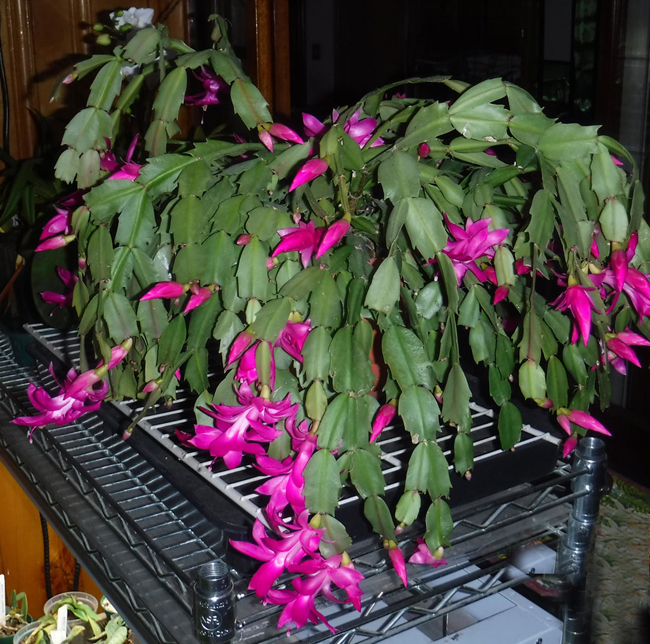
(Photo: Janet Kalisz)
Reflections December 2023
December closes the calendar year; it's the beginning of the Church year, the serious season of Advent, the joy of Christmas holidays and the start of frosty winter. To accentuate these changes, the month includes caroling, street lights, tinsel, colorful decorations, turkey and dressing, Santa Claus and helpers, tinkling bells and chimes, greetings cards and gifts, and perhaps a little snow, if children's prayers are answered. Plants lose their leaves, but this is for them root growth time. Winter is a necessary season, though not as ostentatious as spring. December means vigilance, togetherness, and attention to time and place.
Christmas Cactus |
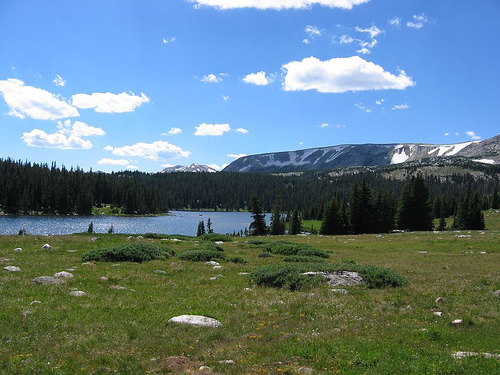
An expansive view. Medicine Bow National Forest, WY.
(*photo credit)
December 1, 2023 Helping Keep America Beautiful
Our country continues to develop and this means that natural wildscapes are often under pressure of development by those who have temporary control over a given space. America's natural beauty was marred when Europeans came in such large numbers over the past four centuries and cut-over forests and eventually crisscrossing the countryside with roads, railways and utility lines. Population growth does not necessarily mean destruction of beauty, but it could, if safeguards are not undertaken, for congestion demands ever greater environmental safeguards. As individuals, we tidy our home and local community; as citizens we press for broad-based governmental practices--and December is a good time to do this.
Zoning is resisted in many parts of our country as though it were a restriction on individual freedom. But ways to restrict unnecessary sprawl are needed to keep America's beauty for all. The soothing effect of well-cultivated lands is harshly broken by the presence of gaudy and ill-placed expensive housing. The commercial sprawl is worse when unplanned development is allowed.
Restricting signs is really a corollary to zoning for development. Billboards, flashing signs, and other such commercial devices are part and parcel of unchecked sprawl. Although they actually cover less land surface than buildings, commercials mar the countryside by disturbing the natural beauty of the viewscape. It is better to consolidate signs at certain key places along highways, or to furnish food, fuel and lodging information and literature on the Internet and at rest areas.
Protecting wilderness areas and especially old-growth forests is a necessity if our country is to preserve larger areas of scenic beauty, such as forestlands and wild areas. The tendency to cut over or use destructive recreational vehicles on such land is a problem, which population pressures exacerbate -- not just the pure number of people, but rather the number of irresponsible users.
Urban homesteading (refurbishing urban abandoned and slum areas through governmental loans and grants) is proving to be a way to furnish residences without disturbing additional wilderness or farmland. The advantages of living nearer the heart of cities are becoming known, and this reversal of land usage (return to the city) may actually slow sprawl and preserve America's beauty.
Gardening in underused urban and rural areas could be a way of beautifying the landscape. A public interest group with which I have been acquainted for four decades is the America the Beautiful Fund (ABF) in Washington, DC. ABF is the largest community improvement organization in the U.S. ABF sponsors many programs, one which successfully distributes garden seeds to volunteer programs, especially within lower income communities.
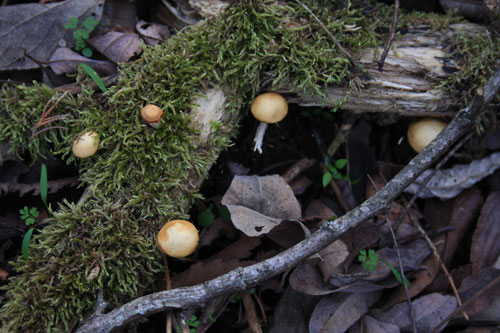
Appreciating diversity of the December forest floor.
(*photo credit)
December 2, 2023 Recognizing Authentic Environmental Stewardship
Why not more emphasis on environmental stewardship? The answer is because "stewardship" has received a special monetary and funding flavor and greens shy away from the discussion. Stewardship is often confused with the practice of responsible property holders who dole out their "possessions" to those deemed in greater need. The practice of stewardship becomes inspiring to these holders and loosens their purse strings. When applied to the environment, this becomes a disastrous misconception; elements of the commons do not belong to individual property holders and thus, doling out should not be interpreted as "charity," for eco-justice is at stake. A proper eco-stewardship is utterly necessary.
Environmental stewardship principles. Stewardship does not mean administering our own possessions through our own decisions and in our own good time. Rather, the Earth is the Lord's, and we are only temporary and cooperative stewards who must see our work as a privilege; thus, the true nature of environmental stewardship is that our talent or privileged gift is to exercise communal responsibility for something that does not belong to us. A second environmental principle is that we are mortal human beings and have only a limited time in which to exercise this responsibility. We have an immense task, an evident need, but we are limited in our time to institute personal and communal resource conservation. In essence, we become stewards of our time as much as of our material resources. We are evangelists spreading Good News to victims -- a troubled Earth and people.
Practice eco-stewarding. At the heart of the issue, good stewardship means responsible caring -- and Earthhealing certainly fits this description. However, when we contest overuse of resources and the attitude that if we are legal owners we can do what we like, we propose a nuanced meaning for "stewardship" that differs from a capitalist absolute ownership model, where dispensing comes out of the goodness of one's heart. On the other hand, when resources are part of the commons, then the community must require and abide by good ecological principles. The current battle over whether to expand palm oil plantations into African forestlands and small farms is one of proper eco-stewardship.
We are expected to be interiorly at peace, but externally restless enough to disturb a tranquility that refuses to challenge injustice. Our planet has been hurt by those with a false sense of dominion over Earth's resources. The disquiet generated by this awareness must be monitored and controlled by those with an interior peace of soul. To preserve this balance, cooperative efforts with others are necessary, since this is more than a solitary individual exercise. Proper stewardship includes placing ourselves before the Creator of all things (including our energy and time) as well as joining with others who see responsible Earthhealing as a cooperative and urgently needed venture.
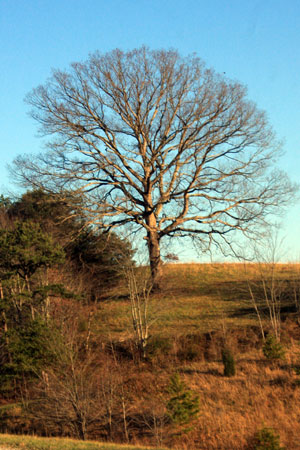
Leafless tree on rural Kentucky farm.
(*photo credit)
December 3, 2023 Becoming Advent People
Therefore, stay awake! To be in tune with the beginning of a new Church Year means that we are to embrace the characteristics of the season and proclaim them to the world. The first seasonal element, vigilance, is what Jesus calls for, a sense of expectancy as to what is coming. The believer awaits a grand finale, and the Lord tells us to never cease, but be vigilant people at all times.
We are to long for the Coming of the Lord in glory and not merely await it with some sort of fearful quietude. Our yearning, as Psalm 42 says, is like that of a deer wanting a fresh drink of running water. The Church is meant to prepare its members for the change that is in process, and to be people who are so close to the Lord that we desire full communion. Our frequent Eucharist is a preparation for the upcoming final event.
Watchfulness and a sense of yearning really usher in a further activity on our part as Advent People; as members of the Body of Christ we participate in the preparation of the Kingdom of God in the present age; we are the Lord’s participants in advancing the Coming and are invited to join the divine venture.
To vigilance, longing and participating ought to be added a further element of openness and collaboration. It is not sufficient that we couple our efforts with those of Christ in our midst and fail to join them with fellow workers in the Lord. Ours is not isolated splendor, but closer cooperation with others who participate as members of the Church. We see these social efforts in a fullness with the Lord in the Body of Christ.
Collaboration with others includes our encouraging them to further action and to tell a world about divine happenings; this world to a major degree lacks awareness of God’s establishment of the Kingdom within our midst. Silence in such matters is not golden; we must announce to the world the need to come closer to the Lord and the need for all to participate.
Our role in announcing is not passive or lacking in urgency. What we experience in our own lives this Advent, is something we want the entire world to become involved with. And this includes living better lives and working for better care of our troubled Earth.
Last of all, Advent is meant to be a transitional time, a period of coming ever closer to Christ himself in the joy of the infancy narratives, the anticipated joy of Christmas and Epiphany. We need to be joyful folks and to resolve to increase our sense of joy over time. Combining all six of these movements in our spiritual life makes us grow in becoming authentic Advent People.
Silence Is Golden
By Fr. Al Fritsch, SJ
We need silence in our lives; it’s something that allows us to focus and concentrate, boost creativity and productivity, relieve stress and cultivate patience. Silence is that time that we can rest thoroughly, not have to talk to others and in some way be completely within ourselves. Silence is a necessary component in a busy and noisy world. Some people (especially young folks) can be frightened by silence, just as with darkness. They like light, and they like business and congestion, and for a certain number of years that may work fairly well. But as we grow older, we need the space and time it takes to let things settle, to be silent and reflect in our own way.
We have much congestion in our world and noise is almost always present. Airplanes flying overhead, jackhammers pounding outside, accelerating vehicles, and before you know it they’re mowing lawns all around, early and late. And we wonder - are there any moments of silence left when we can even repose in a restful manner? We are saturated with sound, partly due to the many electronic devices we intentionally surround ourselves with today, and for that reason it is important for us to talk not to those who love silence, but to the ones who like to be in the middle of things, the noisier the better.
Compromise is one answer to this whole question. Some noise is inevitable, such as when children go back to school after summer vacation and the neighborhood suddenly fills with chattering and laughing kids having fun. Time for that is important and compromise means there is a time to speak and there’s a time to be silent, and we should make that part of our life. Much depends on whether local rules and authorities will insist on this and protect silent times for those who want it. Those who actually enjoy noise making, especially loud music, really understand that they have a certain power over the commons and often want to show off their enjoyment. They may be unaware that exposure to sound more than 85 dB is potentially dangerous. In my own case I have hearing damage resulting in tinnitus, likely caused by the use of a corn grinding mill on our farm growing up. It was so loud you would feel stunned.
Silence and silent time is a necessity in our life, and we’ve got to share their importance with others. Let us be very careful of own noise, and listen, observe and respond to what others need for silent time and space. We can control noise levels near sensitive areas, such as hospitals, nursing homes and child care facilities. We can lower the volume, turn off appliances or shut the door when using noisy machines. One may want to carry earplugs, simply avoid loud areas, or even plant trees for sound barriers. Mostly just take the time to cultivate a quiet atmosphere and remember that in the silence we can always find God, like the whispering that comes after a powerful storm. Let’s listen and find peace in this silence.
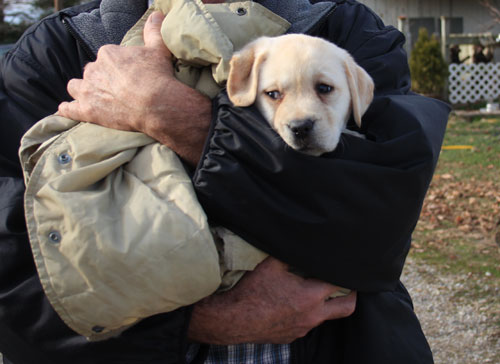
A priceless gift.
(*photo credit)
December 4, 2023 Recording Elders for Holiday Gifts
Sometimes we run out of ideas for holiday gifts, but here is one that is rare and can be highly treasured beyond the season. This year great attention has been paid to attending to our war veterans and their needs. Combining gift giving and care for aging veterans could include recording their memories while their minds are active. Over the years I have conducted several projects that recorded elders who have experience in such diverse fields as chestnut trees to gardening methods. These precious memories become all the more valuable as people near the end of active years and while minds are sharp. Often, younger relatives are the best agents for doing meaningful recordings.
Photographs are a great way of capturing precious memories and should not be dismissed for other methods. The advantage is that digital cameras are most readily available to the wider population. Any form of recording may prove intimidating unless performed after getting the subject to relax and willing to talk. The mark of a good interviewer is that he or she can speedily make the subject feel at home -- for choice opportunities may never return again. Photographs can capture this moment of relaxation so well.
Audiotaping is another, but more sophisticated recording method. Equipment is generally accessible or can be purchased at a very reasonable price. Likewise, the audio recording is far less intimidating for recorders and recorded than videotaping. If properly performed with verbal description of place and background, this method can generate wonderful replication of the elder's spirit and handiwork, and trigger for them precious memories often clearer than recent happenings. One drawback is that listening to the tape is generally less entertaining than watching a video.
Videotaping takes more time and more expensive equipment, but that is actually becoming quite accessible in recent years. Many schools, libraries, friends, or equipment rental places have such equipment that can be obtained for the recording. Semi- or professional help with technical recording may also be available.
Personal interviewing with no equipment may prove more conducive to some subjects. Of course, the talents of the one interviewing and his or her subsequent composition of the written interview is more time consuming, but can be highly revelatory. This is often the most meaningful, but takes greater effort.
Added benefits. Besides being excellent Christmas gifts to the interviewee recorded, such recording teaches the recorder to value captured moments among the elderly, skills at interactive dialog, and proper planning for a successful session. Records are desired by depositories such as university oral history collections or the Veterans Project of the Library of Congress.
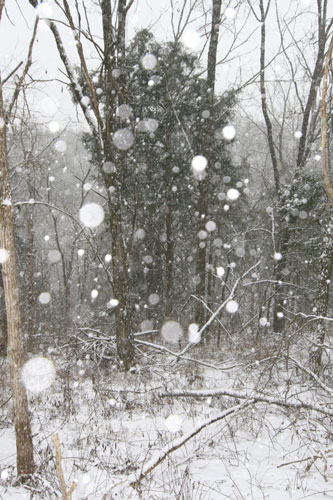
A snowy December walk in the Kentucky woods.
(*photo credit)
December 5, 2023 Observing Tinsel Day Carefully
We live in a society that highly values convenience and comfort -- but on Tinsel Day we ought to look carefully, for many of the allurements around us could be a sham, a show with a shallowness that tinsel often connotes. Tinseled living can extend to domestic, occupational, recreational, and even worship practices. We often hear soothing music emanating from elevators, stores, and even religious radio programming with a host of sweet enticements and sermons. Do we dismiss them as extravagance?
What about a goal of maximum comfort? Religion is meant to be comforting to some degree, for it helps to bring, encourage, and recognize interior peace of soul. However, a religion that furnishes maximum comfort to its members in times of massive suffering, hunger, and lack of basic services in this world, is ill placed. To exclude oneself through "religion" from suffering is to indulge in escape, the opiate to which the communists in the 19th and 20th centuries were so fond of haranguing. In fact, maximizing comfort for affluent people in a troubled world is giving in to the allurements of the Evil One. Contest the maximum comfort goal.
Christ brings true comfort. We must discern, because Jesus speaks a message of personal peace minus any tinsel on all occasions, and especially right after the Resurrection, when the disciples are fearful and afraid. A peaceful interior with all its consolations is a solid foundation and we each need it, for living with Christ is comforting amid suffering.
True religion has a streak of discomfort. The message that truth is not always comforting is not accepted easily by many. In fact, discomfort of any kind is looked upon by these as a work of the Evil Spirit, since they know their consciences bother them at times and to fly from conscience becomes their goal. But the Good Spirit could be the source of some limited discomfort, for God shakes us up a little to bring us back to the straight and narrow path. While fire and brimstone sermons are not popular today, we need to ask why not. Do America's civic religion and the apparent success of some mega-churches bother the rest of us?
Christ confronts a troubled world. Jesus experiences restlessness with certain given situations. The Lord's concerns are for those who do or are wronged, for lost sheep without a shepherd, for fields white with the harvest. Jesus challenges us by not coming to bring tinseled tranquility, but to divide some from even their loved ones. Discipleship demands accepting responsibility and concern. We are in but not of this troubled world -- and this takes discernment. To be in the world means we are like Christ in being restless and yet compassionate (suffering with another). A holy restlessness about a troubled world is Christian, for it includes the healthy balance of interior peace and exterior concern and its accompanying restlessness.

Rural highway below snow-topped hills. Harlan Co., KY.
(*photo credit)
December 6, 2023 Making Harmony Our Spiritual Gift
On the Feast of St. Nicholas, we ask what kind of meaningful gift we can give to satisfy others this holiday season (see December 4th). Obviously, our materialistic culture cries out for us to go on a shopping binge and patronize commercial malls and Internet sites. How do we balance cultural expectations and neighborly needs? St. Nicholas gave all of himself for others both in word and deed, in charity and in spiritual comfort. Truly, some need charitable gifts, but all need comfort (visiting the sick and shut-ins, comforting the bereaved, praying with another, and even confronting the wayward) -- spiritual works of mercy. Harmonizing corporal works of mercy (feeding the hungry) with spiritual ones can be quite challenging in these times, but they can work as one.
Harmony, the potential gift. The harmony found in Christ, who is able to balance an interior peace of soul with the restlessness to confront and enter a troubled world, is what we seek to find and, ultimately, to give. The difficulty is that this gift is not ours to control and disperse, because we are not its author, only its recipient. True religion brings interior comfort and peace of soul, but God is the author of that spiritual comfort even as it resides within us, so how can we give what is not ours to give? Our participation in that peace is our openness to God's power at work through us. What we can ultimately give is the invitation to the other for radical openness to the Lord -- a spiritual gift.
Christ as gift. Christ, God-man, has the unique balance of inner peace and a restlessness to confront and change a troubled world. Here in the union of the divine and human (one person with two natures) is the seat of our testimony as believers. As baptized we enter into the Divine Family and are willing to share this gift as best we can. Herein our own harmony comes into play, for we find the spiritual comfort of the peace of Christ within and we are challenged to help others immersed in a troubled world. The harmony of divine and human springs up in our time, our faith journey, right here and now. The God within is Giver; Jesus is Gift; we are inspired by the Spirit to give, and thus sharing is our gift, and in sharing we are the giving hands of God.
Sharing word and deed is the gift. What then becomes the gift is the harmony that is within us, a harmony that allows us to share with others exactly as God has shared with us. In one sense, this may disappoint a reader for it is so simple; furthermore, it is not too materially tangible. On second thought, if we share by word and deed the harmony that is within us, we proclaim that Christ has come among us and we are the messenger to give this to another -- and we share in the Incarnation. If we express this harmony in the manner we give and perform a deed, we then have given something tangible -- and it is godly as well in its Christlikeness.
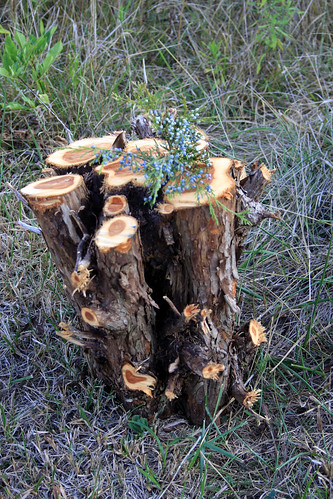
Eastern red cedar, Juniperus virginiana.
(*photo credit)
December 7, 2023 Looking for Lead in the Home
The home is a place of refuge and comfort and yet we should also remain alert, for vigilance and good housekeeping go hand-in-hand. We are all aware of a major source of lead in older homes being lead contaminated house paint of a previous century, but lead awareness needs to go further. Advent is a time for vigilance, especially in homes housing infants, elderly, and pregnant women.
Lead effects. Infants tend to put way too many foreign objects into their mouths; earlier in this century the U.S. Environmental Protection Agency estimated that in our country alone almost one million children ages one to five, have a blood-lead level above the level of concern. The origins of this lead are not always clear-cut, but lead contamination has been with us for some time, especially derived from leaded paint chips and dust and also from the use of lead in gasoline that entered soil near highways, and from lead utensils and other domestic objects. This lead danger applies especially to the young whose growing bodies absorb more lead and whose brains and nervous systems are more sensitive to the damaging effects of lead. Lead effects include behavior and learning problems such as hyperactivity, slowed growth, hearing problems, and headaches. Women may suffer from difficulties during pregnancy; also, there are other reproductive problems for both men and women, blood pressure, digestive problems, nerve disorders, memory and concentration problems, and muscle and joint pains.
Lead contamination. Some older homes built before 1930 still have water pipes made from lead, which can still infiltrate the domestic hot water used. Lead can also come from the solder used to join or repair water pipes or from cistern water collected off of lead painted roofs. Since so much effort has been made in the last four decades to reduce lead use, the problem may be becoming less with time -- but it could still be present, since so many people live in older residences or tend to use older household items that have lead in utensils. Using a metal container for such acidic materials as grapefruit juice could be an unsuspected cause of lead contamination. Also remember, home renovations may remove the lead paint but leave some residual lead dust.
Lead suspicions. Obviously, removal of or ceasing to use lead objects is a first step. Rust-colored water is an alert that water may have metals such as iron but water appearance is not a clear sign of lead content. A good practice is only cold water for drinking, cooking, and for making baby formula and only after draining away the standing water. One must remember that water treatment systems do not remove lead and some water softeners may actually increase the amount of corrosion and lead content of the water. If you live in an older house, have the water tested for lead content. U.S. Safe Drinking Water Hotline: 1-800-426-4791. See Internet for further details.

A swift, chilly Kentucky stream.
(*photo credit)
December 8, 2023 Saying “Yes” to God
Let what you say be done to me. (Luke 1:38)
On the Feast of the Immaculate Conception, we consider God's affirmation to us. "Yes;" it's one of the first words we learn, and yet as an affirmative attitude it may take a lifetime. "Yes" is designated non-verbally through a smile, a gesture, a combination of nod, and facial expression. We affirm ourselves a multitude of times throughout the day and potentially millions of times in an average lifetime. What we do in saying "yes" is to agree with the call of God and the circumstances in which we find ourselves, along with the privilege to say "yes" -- or "no." Merely saying "yes" may not always be the best option, for martyrs and others may have to just say "no" with courage and forthrightness to autocratic demands on them. So saying "yes" is not automatic, but involves the freedom to choose God over others.
Mary is a yes person. The Incarnation event is God's eternal yes to us poor sinful souls. That affirmation is one of infinite love and can only be hinted at in our answering "yes" back to the prompting of God. God initiates, but we must freely accept, just as Mary accepted to be the Mother of God through her fiat -- "let it be done." By accepting, we allow God to enter and reside in our hearts and our whole being. We say "yes" to fulfilling the potential to be totally what God wants us to be.
An equally early word is "no" and that is just as often used and repeated and sometimes for good. Bumper stickers say, "Just say no ... to drugs or alcohol or tobacco." A negative response may be necessary to avoid evil and do good, to flee false allurements and grow in love. With choice comes our many opportunities to say either "yes" or "no" at the right time and place. Sometimes we become confused and must turn again to the Lord to hear God's eternal "yes" in Christ. Jesus always says "yes" to the Father's prompting, and so should we. Our attitude must be one of eternal gratitude for the chance to choose what is right. We reflect on Jesus' way; we feel his power at work in the world; we strive for the Christian virtues; we seek to imitate such models as his mother's "yes" to God.
Our openness enhances a positive environment in which we can say "yes" to God. God creates and invites us into the creative act, but this cannot be achieved with a negativity that includes wrongdoing and lack of faith. We, like Mary, need to be open to grace, a grace wherein we can freely say "yes." Today the dark clouds of negativity seem to overwhelm us on every side, from the culture of death to materialistic allurements. They overwhelm others as well. Can these proceed in freedom to say "yes" to God, or do they panic by peer pressure and allurements to the point at which their freedom erodes. We prepare an atmosphere in which they are willing to say "yes" freely when called to do so.
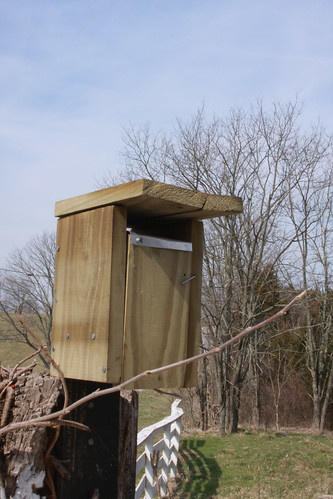
A Kentucky bluebird box.
(*photo credit)
December 9, 2023 Benefiting by Building Smaller Houses
We are developing an environmental consciousness in this country and yet we note that many residences and other structures are built in oversized portions in affluent areas; and these mega-houses, both in this country and elsewhere, are the dream of the upward mobile. Such structures take a massive toll on natural resources through extraction and processing, along with resulting emissions. Larger houses become an irresistible trend that is hard to curb: pressure by home builders and architects to make residences larger and more appealing; desire to keep up with the Joneses with ever-bigger homes; and privacy and convenience demands made by various members of the family. In 1950, the average size of an American home was 963 square feet; by 2007 the medium size peaked at 2,277 and after the Great Recession dropped to 2167 by 2010; in 1950 one-third of homes lacked complete indoor plumbing; today, virtually none; then 45% of residences were rented; today, in 2022, 34.2% are rented and 65.8% owned.
How can we encourage greener and smaller houses, or is that an impossibility? We can relate home size with resource demands with a conservationist argument, but that is generally ignored by the prevailing desire for convenience. Increased size requires more space heating in winter and cooling in summer, more resources to build, and more effort to maintain and keep clean, even with the tide moving towards green efficient housing. It's hard to shame home dreamers by comparing American home size with African home size. Who wants to retreat into underdevelopment? We can appeal to homesteaders who build small basic central structures and graduate with time to those of more space. In the 19th century, ex-pioneers built the large "ante-bellum" brick homes within two decades after the original log cabins were cut from the woods. Starting small and improving with time is lost to many today.
A "small is beautiful" argument still has two cards to play. We need to counter the myth of accrued wealth from inflationary home values; the Great Recession proved that one to be hazardous when "underwater homes," with mortgages greater than home worth, developed by the millions. We need to muster scientific evidence against the practice of "greenwashing" or building modern housing monstrosities with their cathedral ceilings and unused spaces.
One of the worst culprits that solar advocates mention is the sopping up of solar funds by owners of oversized homes that deliberately avoid introducing conservation measures when they add solar features. In recent years, one Midwestern state expended its limited subsidies on a small number of spatially extravagant "solar" homes with no cap on subsidy size. Only a few well- connected affluent benefitted. Ingrained American consumer practices are hard to change, but the comfort of small, cozy, economic, and easily heated, cooling and maintained homes may be the wave of the future. Plan small, build small, live simply.

December sunset, Madison Co., KY.
(*photo credit)
December 10, 2023 Awaiting and Hastening the Day of the Lord
Since everything is to be dissolved in this way, what sort of person ought you to be, conducting yourselves in holiness and devotion, waiting for and hastening the coming of the day of God, because of which the heavens will be dissolved in flames and the elements melted by fire. (2 Peter 3:11-12)
Today's second reading for Advent reminds us that the day of the Lord is coming and we are to await it by being properly prepared. It is an ideal theme for this season and I must confess that this passage was and remains one of the pivotal passages of my activistic career. Why? Because it speaks of "hastening" the coming, for I had doubted that patient waiting in itself could ever be a good attitude. I asked my fellow theology classmate, the late Frank Gignac, SJ (and biblical scholar at that time) whether the word translated as "hastening" had any activistic sense. He assured me that it did and thus it became a key to my thinking.
In the words of the activist St. Peter, God wants us to take part in preparing for the divine coming. This verse is surrounded by imagery of dramatic change when it seems the present worldly conditions will be dissolved by fire. We are to be part of a fundamental transformation leading into the New Heaven and New Earth. However, such imagery need not discourage us. One of the ancient ways of speaking was through fire, not just to destroy but to transform; the raw ore changes through fire to shiny metal and so does our participation in ushering the new age.
The essence of what we get from St. Peter's words is not to hold on to the old with a tightened grip, but rather mold, fashion, and expend effort to bring on the new. We cooperate in the divine transformational activity. So eagerness is both in the awaiting in patience and in being enthusiastic about meaningful change of which we can make our (not just my) mark. Our work is not "make work" or pretending to be a cheering non-participative body. Rather, by our openness and actual work we accelerate the coming of the Lord in glory. We grow in awareness of God's presence and our entry into the process of change. To glorify the Lord is to make Earth's mark of greatness stand forth. The final day is determined by God's judgment, but the fashioning of it includes some human participation by the Body of Christ.
Some will say they do not want the end to come because they champion the status quo and love what they have. Really! Do we enjoy the lack of justice that shows itself so evident in wars and turmoil, in climate change and inequality of resources, in insecurities and materialism? Believers hasten to say "no" to such a status, but may hesitate for lack of courage to go much farther. Maybe the hastening called for by St. Peter demands a streak of courage along with the willingness to work towards that end. We want the Lord to come and are called to do our part.
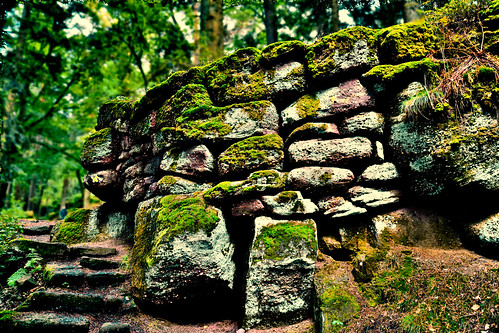
Fortification at Mont Sainte-Odile.
(*Photo by Nils van Rooijen, Creative Commons)
December 11, 2023 Praying to Saint Odile
Saturday is the feast of one of my favorite saints, Odile or Odilia (660 to 720 A.D.), who is also patroness of Alsace and those who have eye troubles of various sorts.
Odile's life is an interesting one that involved her being born blind; her father, Etichon, Duke of Alsace, wanting marriageable offspring, strived to get rid of her. Her mother slipped her to a distant place where she was raised and baptized by Bishop Erhard of Regensburg -- and gained her sight during this event. Her brother brought her back home but that so enraged her father that he almost killed him (her brother). She had to flee again from Etichon's anger and hid in a cave near Basel at Saint Ottilien in Germany. In his pursuit of Odile, her father was injured by falling stones and he finally came to the conclusion he should not harm her. In time, her love for her dad and her nursing him back to health won him over. Etichon then built a monastery in the Hochwald on what is now Mont Sainte Odile; she became the abbess. When her father died he was buried there, and Odile spent much of her time praying for his soul -- he needed it. Odile's chapel and tomb are certainly still popular with pilgrims today.
Mont Sainte Odile, in the Bas-Rhin Department of France, is about 40 kilometers from Strasbourg and is famous as a place of pilgrimage. St. John Paul II visited the shrine at the top of the hill on an official visit to France. The site is truly picturesque with a wonderful view of the distant Rhine Valley. The church in the Fritsch home village of Dumbach in Alsace has a window dedicated to her. I have visited the shrine twice in 2002 and again in 2013, the only place to which I ever took a formal pilgrimage. Both times the beautiful Mont was jammed with pilgrims, something of a surprise in secularized France. At Ste. Odile's Well further down the mountain I bathed my eyes and returned in 2013 in gratitude for improved eyesight. At the second occasion the sun shone briefly during a downpour -- a sign?
Mont Sainte Odile is also an archeological tourist site since here is seen part of a wall built in early Roman times by Celtic inhabitants as part of a Rhine Valley fortification system. It is called the "pagan wall" or Mur Paien and runs for about ten kilometers. At the base of the mountain, we visited a former hostel for pilgrims and tasted some of the best Alsatian wine -- for Ste. Odile's favor continues to this day. What the shrine, the saint, and the pilgrimage itself taught me is that we need sacred places in our lives associated with good people. That combination of people and place attracts others and the place becomes a special environment that is set apart. Through sacred person and place we learn a sense of respect that radiates out to all the Earth. The more we love our roots -- people and places -- the more we desire to take care of Earth, a peopled place.
Wilderness and Wildfires
By Fr. Al Fritsch, SJ
There are many reasons we need to protect wilderness: wilderness enhances watersheds that provide clean drinking water to surrounding communities. Wilderness filters and cleans the air we breathe. Many animals we love call wilderness their home and need that habitat in order not only to live and be safe, but also to find food needed for life. As conscientious people we are interested in making sure that wilderness is always available.
Wilderness is a critically important for climate protection. Healthy forests have a balancing effect on the extreme weather patterns of climate change and permanently reduce carbon dioxide (CO2). They give creatures space and time to adapt to new climatic conditions. Wildfires can fiercely speed through forests and public areas (as happened in Hawaii earlier this year), and can be erratic, dangerous, and more frequent than they used to be. However, Meteorologists aren’t yet able to forecast wildfire outbreaks. Firefighters say there are three conditions that must be present in order for a wildfire to burn: fuel, oxygen, and a heat source. Four out of five wildfires are started by people, but dry weather, drought, and strong winds can lead to the perfect disaster - transforming a spark into a weeks- or months-long blaze that consumes tens of thousands of acres. Lightning is another major cause of forest fires, and scientists have found that every degree of global warming sets off a 12 percent bump in lightning activity. More lightning, more fires.
Wildlife is the primary inhabitant of wilderness; however, human beings have more and more impact there over time. In establishing ourselves in the wilderness, it ceases to be wild and becomes only another entitlement and not for the wildlife. Driving along the interstate you sometimes see a beautiful landscape ahead with lush acres of trees, and looming above it all a gigantic house looking out on the wilderness. Most likely none of the readers of this essay own those homes, but many of us do live in what are called wildlife and fire zones, areas that with the right conditions could burn rapidly. So we understand fully that we must be careful with combustible materials and conditions. I have retired friends in Colorado who cleared their land of underbrush and house-overhanging trees. The surrounding forest is thinner than a normal wilderness, but very beautiful and in good condition.
People can prepare their property to resist fires, provided they’re also working with neighbors of like-mind. We have wildfires in Kentucky frequently, and an associate went out to help the Forest Service fight those fires. Inexperienced, he became surrounded by fire and we finally got him out before it was too late. Fighting wildfires is dangerous work and demands respect, but we can prepare our own habitats to mitigate damage if a wildfire occurs. Wildfires are becoming far more common and it’s worthwhile to have a disaster plan. To evacuate ourselves if we need to get away fast and have a bag of important items just in case. Let’s also try, as much as possible, to save our wilderness and biological diversity, and slow devastation of wildlife, forests and the environment. Remember that wilderness is our national treasure.

Red poinsettias in mist.
(*Photo by David Noah, Creative Commons)
December 12, 2023 Noticing Poinsettia Day and December Plants
Today we celebrate the feast of Our Lady of Guadalupe, patroness of the Americas, along with Poinsettia Day. According to tradition, on this day we recall the appearance of the Virgin Mary to Juan Diego, who convinced the bishop of Mexico City by opening his cloak and displaying the image of Mary along with a shower of roses on that cold December day. The favors of heaven show in flowers that are a form of divine communication with us. Yes, flowers are favored symbols and they are important during this non-growing portion of the year, especially near the Christmas season.
Christmas plants include the poinsettia, the color of which is really the bright red leaves that surround the plant's flower. This plant is a favorite American decoration, even though many of us would regard it as purely a Mexican plant. Other forms of vegetation have their prominence during this month (e.g., Christmas cactus), extending to a variety of evergreen boughs used in temperate climates for decorations. Holly is a favorite due to its deep green color and its ability to withstand the dry interior conditions of the domestic atmosphere -- and the beautiful red berries adds to its appeal. "Deck the halls with boughs of holly." Mistletoe, a parasitic plant growing on evergreen or deciduous trees, with pale green leaves and poisonous white berries, is an ancient decoration which we favored in my youth; men may kiss any woman standing under a sprig of this at Christmas. We would shoot off a bunch with our trusty shotgun for home decoration.
In post-depression days, our family would make a family hike in mid-December and select a nice native red cedar (Juniperus virginiana). This choice "tree" would reign supreme in our home and be decorated for a whole month in a prominent place. Our farm had limestone soil and thus many cedars, a "weed" bush. However, the selected tree filled the house with a wonderful scent, which to this day reminds me of Christmas -- simple but exalted and fitting in beauty and economy. Though some regard cedars as pests, they were our friends, always greening the sparse and gray countryside, a good hedge, and with long-lasting fragrant wood with preservative qualities, especially as cedar chips and chests.
Another Christmas plant is salsify root, the "oyster plant," which is cooked in exactly the same way as oysters and eaten as a non-meat/fish dish especially on festive occasions. This reminds us of a host of other plants and parts used as nut or fruit or berry for the holidays. What we soon realize is that the Christmas message is told through plants as well as through animals (see December 15). Christ comes among us all, and plants enter his life just as do animals -- frankincense and myrrh as Magi gifts, figs and dates, dill and rue, and grapes and wheat. Earth is clothed in its plants. We would not live without fruits, grains, grasses, berries, nuts, and vegetables.

Solitary candle brings light to December evening.
(*photo credit)
December 13, 2023 Lighting Candles amid December's Darkness
Today is the Feast of St. Lucy, one of the ancient Italian virgin martyrs (died 304) whose popularity never waned. Lucy is derived from Latin Lux meaning light. Placing lighted candles on wreathes and Christmas trees can be quite dangerous, but not near so as the ancient Scandinavian practice of a lighted crown of candles worn by maidens on St. Lucy's Day.
Perhaps people with electricity no longer value the "candle," as did our ancestors who used these for lighting and domestic tasks, for illumination and for decoration, for festive occasions, and ordinary things of life. Some lit them when saying a prayer. Are candles losing their value? We use Advent candles in reference to Medieval ox cart wheels brought next to a fire place to keep them from warping. As the autumn gave way to winter more and more candles were added to compensate for the growing darkness, thus one and then two, three and then four candles near Christmas. Candles' soft and comforting light remains a Christmas delight. Let’s extend the season to liturgical festivals.
Formerly when candles were expensive, a multi-candle event showed its importance (High Masses had six lit candles while Low Masses had only two). Making liturgical candles from beeswax adds to the expense, since securing this source of fuel takes many beekeepers, to say nothing of the bees themselves. Candles mean celebration and hospitality, and give dignity to events -- a fact recognized from the youngest, fascinated by candles (and blowing them out), to elders, who recall candle lights in past gatherings.
Advent, Christmas, Hanukkah, and birthday party candles tell us much and seem to trigger our hidden treasures of sentimentality. Candles both bring us back to past events and point to our future journeys. One candlepower is a small unit of measure and yet when derived from a humble candle has immense potential. Candles are not only conquerors of darkness when days are short, but the deliverers of light, well within the range of usefulness. Candles become signs of hope, for we need the flicker of light to show our hidden strengths. We all prefer gentle light and enlightenment, not the harshness of a bolt of lightning or the brilliant flash of insight that shatters all previous misconceptions.
Jesus says he is the "light of the world." We reflect that this light means photosynthetic enlivenment, a lighthouse in the storm, and a vanquisher of domestic darkness. But we often forget to connect light with the source of light. Jesus must have had a special love for candles, just as much as for lamps that gave light by burning oil. Perhaps one of our reflections about divine light could be the physical source, for we are to be fuel-conscious folks. Let us start to think of light from candles, and then realize the softness, quality, and host of accompanying thoughts that go into lighting a candle in mid-December.
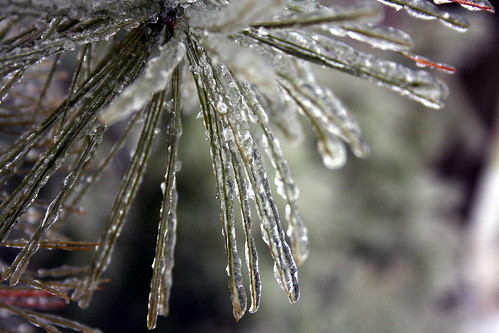
Icy needles on eastern white pine, Pinus strobus.
(*photo credit)
December 14, 2023 Mobilizing Faith-Based Communities
The ending of the Feast of Hanukkah tomorrow is a good opportunity to reassess our interaction with the faith communities, especially on environmental matters. This could be done as interactive religious efforts at moral consciousness-raising activities, to be undertaken by religious institutions and through joint ecumenical endeavors. We can do many things together because of common moral objectives.
Moral awareness. A while back, Professor E.O. Wilson of Harvard discussed on National Public Radio why he was attempting to relate to evangelistic faith communities as a scientist; he said that communities may differ about the origins of the Earth, but not about its fate due to environmental damage. Most evangelistic and other faith communities would agree that having dominion over Earth does not mean that people can trash it, but rather that all people of good will should become involved in caring for Earth. Thus, environmental responsibility rests on a common ground of morality. Wilson mentioned that damage to this planet reduces the effectiveness of eco-system services (natural water or air purification services, etc.); he said the latest estimates were that this damage amounts to an estimated $30 trillion per year, or more than the total annual output of human goods and services.
Religious institutional activities. A deeper level of awareness is what each community could do in order to become good models of eco-justice. Here at this deeper level is where many of the faith-based groups (some of whom we helped with environmental resource assessments) fit into the picture. Many practices, from proper land use and gardening to renewable energy and conservation, fall into green activities -- and faith-based groups can obtain basic assessments and undertake ongoing auditing over the years. Each group can encourage nearby folks to become green neighbors.
Joint environmental endeavors. Back in the 1980s, I strived to work with a group called the North American Conference on Christianity and Ecology. We held a successful conference of over 500 people assembled in Indiana in 1987, but the headaches in putting on this affair and keeping the organizing group functioning gave some of us a new insight. It is far easier for faith-based groups to work with other environmental groups in their locality, rather than to try to harmonize theological and judicatory differences. Mobilization could be either working together as faith-based groups or immersed with others -- and from experience, religious/secular activities take far less time and energy; two or more faith-based groups could be present, but clustering of diverse faith-based groups on a far-reaching issue like the environment is fraught with some wanting to grasp a pulpit and promote their evangelism. Faith-based groups should be stimulated to take part in broad-based environmental activities, for the sake of furthering our ecological collaboration.

A beloved pet shares a quiet moment.
(*photo credit)
December 15, 2023 Welcoming Animals at Christmas
Today, "live crib scenes" are being assembled and caretakers are feeding and freshening the bedding; this is for livestock that are being brought to enliven the stable backgrounds for these Christmas crèches. If we recall history, we thank St. Francis of Assisi for including animals in that first crèche -- and he is a friend of animals. His inspiration allows us to see all creation welcoming the Christ child's coming into the world.
Crib scenes, whether statuary or those with breathing livestock, include primarily the shepherd's sheep and lambs. We still call Jesus "the lamb of God.” Since herders had mixed flocks of sheep and goats the various animals are welcome in the living cribs of our world, along with cows and watchdogs. The stolid oxen and perhaps donkeys were most likely regular inhabitants of that first cave/stable. They were the means of transportation of goods and of the people who traveled to Bethlehem and about the Holy Land. Last of all, the crib scene changes as we move closer to the Epiphany and many insert camels used by the Wise Men from the East. All these varieties challenge the preparers of living cribs today.
Animals fit conveniently in the story of Jesus' ministry. Wildlife are his companions in the desert during his forty-day retreat prior to his public activity. Remember, Jesus speaks of the birds of the air and their contentment and lack of anxiety; he mentions sparrows as well, and God's concern over them. Fish enter into the picture quite often because of the employment of the majority of the disciples and the food of the people. And, if we include Old Testament accounts, more animals appear, from ravens and whales to snakes and horses.
Animals are companions who accompany us, assist us with burdens, give us enjoyment, and enliven our surroundings. Pets are God's gifts to help harmonize our lives. Jesus' coming is for all of "us" and this includes the plant and animal worlds. We should never overlook how much we humans depend on the entire family of creatures for livelihood and companionship. Earth would not be full without animals, and a human population minus animals (hardly conceivable) is beyond our speculation. Jesus comes to establish a New Creation and, in the words of both Old and New Testament, a New Heaven and New Earth. Is this "New Earth" in the making devoid of animals? We know more specifics than we care to mention: lion and lamb live at peace with each other.
Ecology and its patron, St. Francis, indicate a simple reality that becomes a wee bit speculative: animals are part of salvation history -- that ongoing series of events that brings about the culmination of all things in a return to God. For most of us, animals are friends and companions. What is good enough for infant Jesus is good also for us. Do our animals fit into our eternal quest? And are the animals we love part of our eternal life?

A rustic shed in rural eastern Kentucky.
(*photo credit)
December 16, 2023 Addressing a World of Bullies
In the past we have mentioned bullying, especially at the local level (see October 2022, but ought we to extend this discussion to broader levels than homes and schools?). We know that a militarized society with guns available in ever greater numbers changes the very nature of police forces, to where the equipment and manner of approach transforms neighborhoods from being protected partners into competing power groups; this atmosphere triggers the rise of instances of bullying in unexpected ways. Bullying is a weapon of power; when accompanied by guns, this power is magnified. Perhaps the person refuses to fight it out and this leads to use of guns by either the bully or the one who is the brunt of the actions. Reactions can be as drastic as original actions, for bullying is often competition gone awry.
Bullies hardly know what they are doing; they try to impose their will over others through forceful action or hostile language communicated in order to get results contrary to the will of the victim. Even the mass media that attempts to make changes in social morass leads to forms of bullying that were unknown just a few years ago. They urge you to adopt certain practices, for that is the right thing to do. Peer pressures have an element of the bully. In this age of easy social media, bullying may include threatening another by revealing a real or hypothetical story that imputes another's character. This may begin as a local matter, but soon turns into telling the world about an ex-friend or enemy, with little recourse to correct or balance a reported issue.
Guns speak when holders exercise a rather silent bully pulpit, especially in troubled unsafe neighborhoods. Bullies and the bullied fester and can reach for guns. Many of recent American massacres involve newly minted gun bullies who prefer these cleaner-than-knives weapons. Even the wealthy can bully the poor through peer pressure and through advertisements pushing people to buy certain products or act in certain ways. So can terrorists who threaten to blow up unsuspecting people, whether those leaving mosques of a different persuasion in the Middle East or those who plot and carry out a dramatic act such as destroying the Twin Towers in 2001. We all live under threat of the suicide bomber, coming when least expected, and adding fears to prove a point.
Well armed nations can and have bullied, e.g., Hitler and threats to Czechoslovakia. What about U.S. historically bullying Mexico, Columbia, Dominican Republic, Cuba, and many Latin American lands? Pretexts were drummed up to start hostilities. Through the Helms-Burton Act, American delegates to international financial systems such as the International Monetary Fund have been required to vote that Cuba be excluded. Are we bullies as individuals due to national militarism, or does it work in the inverse? Bullying works both from bottom up and from top down.
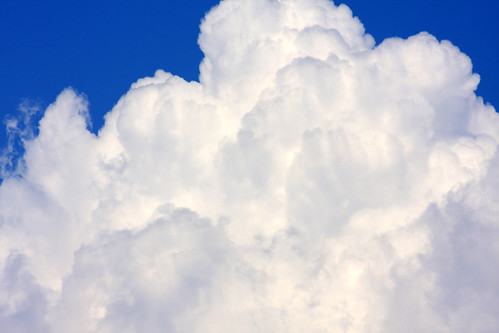
Mid-December blue sky with billowy clouds.
(*photo credit)
December 17, 2023 Being Joyful Heralds and Evangelists
The spirit of the Lord Yahweh has been given to me,
for Yahweh has anointed me...
to proclaim liberty to captives,
freedom to those in prison. (Isaiah 61:1)
In Advent, we reacquaint ourselves with the historic past and see ourselves as forerunners of a glorious future. Ours is then a unique journey of each individual, and it is a continuation on the long communal journey in time, a testimony to a horizon ahead, and a willingness to live joyfully today with the Spirit of God.
Travelers of old. John the Baptist, last of the prophets in the tradition of the Old Testament, was that voice in the desert who fulfilled the words of Isaiah the prophet. And he was a transitional figure, a bridge, from the Old to the New Covenant. In the time of Christ, the Romans were ace road builders; the spread of Christianity could not have occurred as rapidly had it not been for the Empire and its excellent well-engineered and relatively safe roads. Traveling in ancient times was truly a "journey" of toil, not today's pleasure trips. The prophet Baruch (5:1-9) tells a different travel narrative of exiles returning with hope and joy.
Being heralds today. We prepare the way bringing Good News and preparing people through pre-evangelism to receive the word. A materialism and selfish affluence must be challenged and confronted through advocating simple living techniques and resource conservation. True heralds live what they preach, for deed and word must be in harmony. If conditions are of decadence and gross ruin, then we must help correct the environment so that a good quality of life is possible. Heralds of Good News must be doers of good deeds, and then be evangelists -- but first doers.
Being evangelists today. As Paul says in 1 Thessalonians, we are to test everything and hopefully be preserved blameless for the coming of the Day of the Lord. All our being is to focus on making the road easier for those around us so they may receive the word in joy. Salvation is for all, and we are on an urgent mission, the healing of our fellow human beings and Earth herself. We need to live simply so we can be in harmony with our Earth. Through example we speak with integrity as a prophetic people who have achieved a lifestyle that fits the saving words proclaimed. Affluent evangelists sometimes spread a false "prosperity" Christianity; simple evangelists proclaim a true message of joy.
Challenged to live in joyful harmony. Some regard the practice of their religion as private matter. However, Christianity is public worship; our interior spiritual life must be made public for others to see so they can judge. Prophetic word and deed work together and are public acts, and these are joyful when working in total harmony as worthy faithful witnesses.
The Art of Gift-Giving
By Fr. Al Fritsch, SJ
This is the season of the year in which we give gifts to others because they, in fact, give gifts to us. And we can consider, as Christians and recipients of some of God’s great gifts that we have received much that we can’t even remember. These gifts are best celebrated at the end of the year when we prepare for the new one, when we look back and show our gratitude for all that has been given to us.
Giving is of importance to us; it gives us joy. But there is also an onus connected to it, that is, what am I going to give to this person in return? Does my gift’s value match what was given to me? There’s a frustration involved in figuring out exactly what is the proper thing to do at a given time, and then to prepare and present it in the necessary fashion. Of course, in the act of accepting and appreciation, we find joy too. Therefore, the entire process moves from being an onus to a joy, all in the fact of us giving to another person.
So the act of giving also includes the act of receiving. As mentioned earlier, we receive numerous gifts from God, including the freedom to say or do the right or wrong thing. Our very existence comes from the hands of God and includes our friends and relatives who help us through our life. We receive so many freely-given gifts, but how do we receive them? In a perfunctory way? Say thanks and forget about it? Or do we actually receive with a sense of joy that reciprocates the joy of the giver?
God’s gifts to us are something that we must always remember, especially during the Christmas season and that of the other associated church holidays. We have to recognize the great gifts given to us, receive them gracefully, and try in some way to thank God for this in gratitude. When we fail to do this, we are like little kids who grab, grab, grab and always want something more, never fully understanding the value of what has already been given.
This brings us to the material gifts themselves. There’s an advertisement going around this year of the twenty best gifts to give in 2023, averaging about $60 each. These are all kinds of crazy things, very exciting and flashy top list material gadgets, but seemingly devoid of emotional relevance and identity. A lot of people think of gifts only that way. Whereas we could approach gift-giving as a sort of prayer and offering of service to another, thinking about the happiness of the recipient. For Christmas and other holidays to be focused on consumer goods is a sad modern contrivance.
The gifts that we give should come from the heart and reflect our personal identity and relationship to the recipient. It’s important that we consider the act of giving and receiving as a reflection of God’s glory and generosity. Spend a few moments this season thinking about what could be shared directly from your life. We should thank God for so many good things given and also encourage others to show gratitude and thanksgiving, and try to extend this to include those who are usually forgotten in our society. All in all, the precious art of giving is something to hold in the highest regard.

Frost on remnants of coral berry, Symphoricarpos orbiculatus.
(*photo credit)
December 18, 2023 Exploring Internet Freedom and Neutrality
The preservation of Internet neutrality has been a major concern from the times of its founding. Large companies want faster service and special privileges over competition, with a potential to making a fortune. We take Internet freedom for granted and the FCC in 2005 set policy principles in which all consumers are entitled to access the lawful content of their choice; connect their choice of legal devices that do not harm the network; run applications and services of their choice; and competition among network providers, application and service providers, and content providers.
Now the valuable source of information and communication is neutral, but powerful phone and cable corporations would have it otherwise, if they can persuade the U.S. government to restrict access and charge fees or to have special privileges. We might think this an improbable situation, but it is not, for the Federal Communications Commission stands at this time for commoners. The current Administration is in favor of net neutrality. Those who think otherwise are quite numerous and vigilance is needed, for Internet privilege is tempting when in the hands of profiteers.
Phone and cable companies have spent millions of dollars each year with lobbyists, political campaigns, and public relations firms in order to influence legislation that would deny network neutrality and favor a closed or toll-setting Internet system. Concentration of money continues a national and global pattern of reducing freedom and ceding public access to private interests such as powerful communications companies. For the common good, public control and access is imperative.
Interested citizens would like to keep Internet neutrality just as it is -- a product of the commons for all the commoners. Amazing that the fencing of the Commons is an ongoing temptation when people are allowed to exercise freedom and have funds to make changes. If some neutrality were broken, our website and others would have to close for lack of resources. Free and equal access, like public highways, must be open or little fellows will not move easily. The same applies to the network commons.
Advent is a time of guarding what we hold dear. Each of us should take Internet neutrality seriously and realize that the billions of dollars at stake make this a tempting arena for private take-over. The various groups that have kept us abreast of this battle deserve our support. The coalition of groups "Save the Internet.com," has acted as a pre-alert system for defenders of Internet freedom. Yes, bipartisan members of the U.S. Congress have sponsored bills to protect Internet freedom. Let's keep abreast of this issue by writing letters, making phone calls, and signing petitions to be sent to national legislators and administrators on this crucial subject. Stand up for Internet net neutrality issues and guard against lurking web-thieves.
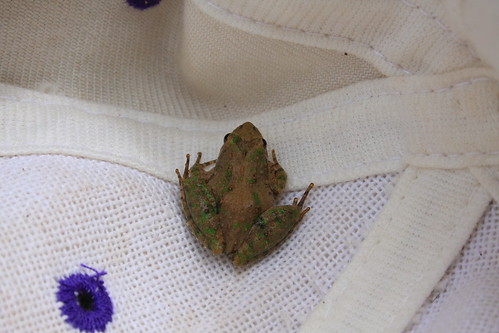
Tiny frog in cap.
(*photo credit)
December 19, 2023 Being Aware of Underdog Day
The "underdog" is the one who is losing in a dog fight, and that designation is shared by people or groups who are expected to lose in a competing struggle. Also, those who are handicapped or have some disadvantages are regarded as underdogs. In one way or other, Earthhealers are all underdogs, but we struggle against great odds to save and enhance our environment. We may have a certain degree of support but, when push comes to shove, those who champion less popular causes are truly underdog lovers. Today we may regard the "environment" as defenseless and thus in need of defenders to protect the underdog. The same is said for Appalachian culture, middle class values, intercity and African American youth, Hispanic migrants, and just about any group or individual that is not part of the majority.
On second thought, many do not compassionately love the underdog. They regard the one at the bottom of the heap as deserving to be there. Many prefer to cheer for "number one." Americans may like the winning side and that means despising the underdog who might as well fade into the shadows. They say "who likes the loser, the bankrupt, the jailed, the marginalized, the voiceless, the invisible, or the flunked?" Favoritism for the loser is for them unpatriotic and non-competitive. American dogs are not peaceful; they are meant to fight -- and win.
We can conceive of "underdog" in many ways: stoically, we accept that we are truly underdogs and can do nothing about it but suffer; sociologically, we can strive to understand how an individual or group gets into such a position; religiously, we can pray for the underdog so that he or she will not lose courage. But then we move to another psychological/political level: why “overdogs” and underdogs? Why dogfights in the first place? Under and over denote strata that should not exist -- a real but unwanted class system. It is not that we strive to elevate underdogs from the bottom of the heap; just why a heap? A world of underdogs of whatever sort is not a world in harmony. If school grades are posted as to position in a class -- someone is at the bottom. If they are not posted and all competition is within oneself, then why such competitive positions?
Underdog Day is also Bill of Rights Day, and the second should be a clue to how we should consider the first. Rights are what we have by nature of our person, though we can never be equal in all aspects. Human beings are unique and endowed with different gifts, but all gifts are worthy of recognition and glory. Through uniqueness, we are not so much over or under others as far as gifts go, and contrasting can be grossly unfair. Putting everyone into a contest in which certain ones undoubtedly have highly rated gifts, makes the contest unequal from the start, and is directed to the victory of privileged dogs -- who hardly deserve the title.

Sundog around December sun.
(*photo credit)
December 20, 2023 Reflecting on Finality
Finality
Each season gives clues to where we are,
and how the earthly journey goes.
A loud telling, life's unfolding,
which the Puzzle Maker heralds.
Fall draws into line our earthly time,
yet returns to circle again;
for lines and circles form around
the coiled spirals of mortal life.
These sweep up our beings far beyond,
on snowy roads and iced potholes,
past naked trees on silent hillsides,
to wood fires and yuletide carols.
Happy Winter Solstice!

Fragrant and delicate paperwhites grown indoors.
(*photo credit)
December 21, 2023 Glistening Prison Razor Wire at Christmas
The somewhat scenic glistening razor wire fencing at the Manchester federal prison still attracts attention for those free enough to be standing on the outside. However, over the years this has been a time of heartfelt sadness for the thousand or so prisoners within. Age has forced me to give less time to these prisoners and so I miss their Christmas gatherings. For many decades, the prisoners had the comfort of visits by Sister Mary Glass, who made them her special ministry in her work with the poor in Clay County; inmates regarded her as a second mother.
A prison on Christmas night gives a bittersweet message; in one way there is a unique beauty, for it is a vast light display due to powerful floodlights. However, that can only be appreciated by those who are free enough to be on the outside. For the inmates there is no display, for they are confined and cannot see the total picture. When the spotlights are shining during a wintry night, the place sparkles like sprawling shrubs adorned with a million Christmas lights. Those who pass on the public highway have a chance to admire the scene.
Behind the fences are over one thousand unfortunate human beings who are segregated from society and isolated from the normal home life of this holy season. Some keep the secrets of their own offenses in fear of being shunned by fellow prisoners or because these are private matters -- a condition of theirs that we must honor. Some remember the hurt and shame of loved ones back home due to their incarceration. Others regret the loss of time for making a decent living for their families. All hurt separately and most especially at Christmas, which is family togetherness time.
Prisons in Appalachia have become a growth industry, an opportunity for employment for local residents. America has more prisoners per capita than any other industrialized nation and our country almost delights in incarcerating them in expensive institutions; we neglect to give them programs through which they could make positive contributions to society. We have much to learn, even from primitive cultures, on how to rehabilitate offenders and allow them to do meaningful service in society.
On another level, the prisoners make the best of a rather difficult situation, and their efforts are worth encouraging. Many try to help their cell neighbors in their own way -- and do. Some even express appreciation for the specific prison blessings that they have received. The Good News is that efforts are now afoot to reduce prison populations and shorten sentences of non-violent offenders. We should redouble our civic efforts to demonstrate to citizens the great cost in human lives that are in what are mistakenly called "correctional institutions." We should advocate that ex-felons be allowed to vote and participate in civic duties and services.
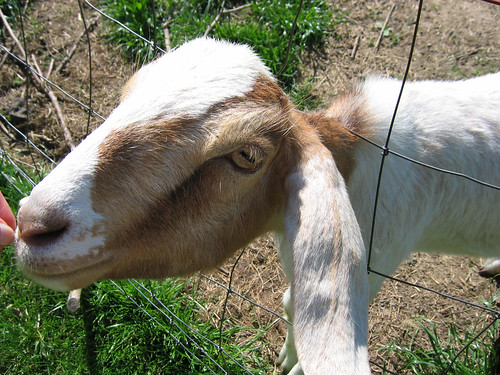
Goat on rural Kentucky farm.
(*photo credit)
December 22, 2023 Discussing the Benefits of Goats
Once a month we feature a particular animal. Though mountain goats are in the American West, the domestic goat imported from Europe is more familiar in Appalachia and much of the East and Great Plains. Thus, our interest is not in zodiac signs, but rather to the caper (goat) and cornu (horn of the goat), with our attention given to the domestic animal, not the stars. Goats certainly have benefits from milk, meat, and ease in care. Still ambivalence prevails. Grazing goats as livestock in various parts of the world has led to deforestation, for their wide-ranging appetites include planted saplings and just about everything else that is off limits. Goats have overgrazed the Middle East.
A bad experience. Back in 1982 our ASPI nature center was given some prime quality goats, and we attempted to keep them but found they loved to hop onto young trees to get the topmost leaves. So we tethered them, and soon passersby were totally incensed that we let them get tangled in the tethering cords. For the sake of the forest, we had to pass them to the Heifer Project to give to Appalachians with cleared pasture land and good fences. Though visitors loved them, goats don’t do well in nature centers.
Goats are beneficial; they are most friendly and affectionate, and thus one of the best uses of goats is for pets. This is true of all varieties, but larger animals require more grazing room, and goats like to live with others and are quite unsatisfied alone. So if one has land enough, fencing enough, and shelter enough, goats can become good pets, especially the pygmy or dwarf goat varieties. Like all pets these goats require feed, shelter, and medical care. Another unusual use of goats is as companions to horses and other livestock. To "get my goat" refers to this utility. Perhaps other animals tolerate the presence of goats as a blessing as do children and some adults; they are affectionate.
If one is going to such trouble, why not double goat pets with livestock and obtain milk products or beasts of burden for very light-weight carts? Some might add that goat meat is preferred in many lands where their presence is part of the countryside and feasts include the sacrifice of the goat as part of the meal. Except for certain ethnic groups, goat meat is not popular in America. However, here varieties of goat's cheese are highly prized and goat's milk is prescribed for people with certain deficiencies; dairy products give goats an economic agricultural importance that has stimulated more goat farms.
Goats give a place a sense of well being, but like all livestock they demand regular attention and care. Yes, goats can make people stay at home and enjoy the local scenery. If one must travel, it is hard to pack goats in the car; caretakers must be found and, if not, an additional advantage of goats is that they make us use vehicles less and stay at home more.
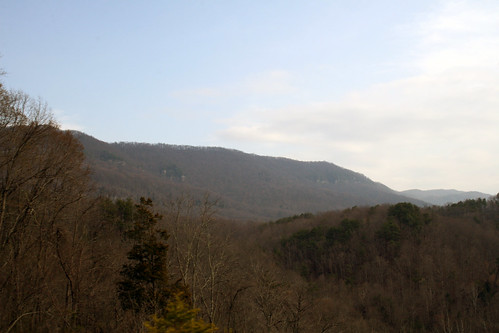
Hills of Harlan Co., KY, in winter.
(*photo credit)
December 23, 2023 Coming Milder Winters
Another winter is upon us. As people get less mobile and find cold weather and icy conditions harder to negotiate, they come to dread this season. Perhaps global warming is not all disaster, if winters become milder, though that is not necessarily the upcoming prediction. Weather extremes could become more frequent -- and that might even mean more snow for some areas (note the last few winters). Climate change has its quirks; however, our recent yearly weather on the planet is in the direction of fewer winter days in the Northern Hemisphere and extended springs and autumns. It is quite possible that warmer overall weather even in winter could still be accompanied by higher snowfall levels and severe storms when they do occur during the season. In the past decade I have used my snow shovel only once, but our region may be an anomaly for there has been heavy snowfall all around us. Let's be optimistic and expect milder winters.
Advantages of a mild winter: The season appears to go faster in milder weather; severe weather conditions leave an impact; the temptation to travel south is lessened; space heating bills are reduced; less snow removal (though good outdoor physical exercise) is required; there's less use of salt on driveways; dangers of slipping on ice or driving on treacherous roads is reduced; mobility is maintained; we can get to appointments that would have had to be cancelled due to unexpectedly bad weather; we can see more of the ground squirrels scurrying about in the dead of winter; school schedules are less disrupted; more opportunities are available to do outdoor hiking and winter camping; more migratory birds together with our opportunistic Canadian geese residents will stay near; fewer injuries occur due to winter automobile accidents and perhaps fewer colds and flu; winter crops such as collards continue to produce; and we don't have as many weather-related issues to complain about -- though good conversation starters.
Disadvantages of a mild winter: We need the cold weather to "set" certain temperate fruit trees (we could plant other varieties); we lack the beauty of the snowy countryside and the utter quiet of falling snow; we don't have a chance to try on our heavier winter clothing; the fireplace does not seem so inviting; there is less of a smell of wood smoke in the locality; a softening of the great differences between the seasons can be observed; there is less of the insulating effect of snow cover on the roof; we miss drinking hot chocolate when it snows; mosquitoes are more able to survive in milder weather and tropical and semitropical diseases are edging north; we do not have as many opportunities to get out and shovel snow; there is less time to rest and read the reserved winter reading materials; we track in the mud if we are not alert, just as we are free from tracking in snow; we miss the excitement of the great blizzard of ---; and we don't have the conversation of weather to complain about.

Razor wire provides protection for mourning dove.
(*Photo by R. Dingman, Creative Commons)
December 24, 2023 Recognizing that Emmanuel Is Present
Send victory like a dew, you heavens, and let the clouds rain it down.
Let the earth open for salvation to spring up. (Isaiah 45:8)
During Advent, we go from the first Sunday's longing in our hearts for the coming of the Messiah, to the second Sunday and the prophetic manner of acting, to the third, which is to act with joy and enthusiasm, and now we focus more intensely on the heart of the Christmas message -- Jesus Christ.
The Incarnation. The great event of God coming among us unfolds in Luke's Gospel as a narration and announcement -- and a free act on the part of Mary to be party to this monumental event in human history. Here heaven and Earth kiss. The quote above from Isaiah 45 is translated in different ways, and the translation used in today's Liturgy speaks of "victory" being the Just One and "salvation" in terms of the Savior. In many ways, this second translation focuses on Jesus Christ the person and not the great happening in non-personal terms. What is so great about either translation is that the two directions (Heaven and Earth) are forthcoming -- from Heaven the Just One (our God) comes and from Earth the tree of the house of David and Earth from which we mortals spring. The two come together in a single blessed event.
Our Origins. We have our earthly origins from parents and on and on back in history. We are descendants of people of faith. They believed in the future to such a degree that they bore and nurtured children and these were the result of free acts of faith and courage. For about 99% of us, our ancestry is only a few generations of names and dates. We may not be sons or daughters of David, but we are sons and daughters of noble people. We honor their memories and graves; we celebrate their lives; we revere their photos and keepsakes; we are proud of our forebears.
Our Hopeful Destiny. As people of faith, we look back and we look ahead. The story starts at Nazareth, but that in one sense is only a way stop. Here history stops as well for a moment -- this is the most important announcement in human history. As St. Paul says, the mystery hidden for many ages is now made known to all peoples so that they may believe and obey. Jesus comes among us at this Christmas, a hopeful ray of light in a world extending into the future, and giving us courage and energy to move forward.
The Lord is present and, as our consciousness grows for the coming of the Lord, we find the presence of the Lord ever more meaningful in our lives. Emmanuel, Lord with us, makes us more willing to present Christ to a wider world. We declare his presence in word; we prove his presence through loving deeds that speak louder than word. Christmas is a present moment, not merely a past birthday or a future coming event.
Broadening the Christmas Spirit
By Fr. Al Fritsch, SJ
Amidst all the chaos this season can bring, take some time to pause and evaluate what’s truly important. Christmastime is characterized, depending on who’s looking, in many different ways. For some it is a great event of deep spiritual value, for others a more secular one with the exchange of gifts or good wishes being the highlight. And for still others it is no good at all and therefore should be abandoned. Christmas comes in different ways to different people, and we could argue from a Christian viewpoint that there are a variety of Christmas spirits which join others together to co-celebrate events beyond their own belief, because it involves a spirit that extends beyond it. For others the season is considered worthless and to be forgotten. But for Christians it is important to work together with people, especially in this time when some are trying to shift the Christmas narrative. We must learn to sort and evaluate various Christmas symbols and their use, different salutations, traditions, decorations, and even the cross at times, not forgetting the trees that are present and many other examples where the Christmas event is celebrated in a more spiritual and religious sense.
We realize that Christmas as such actually evolved as a feast day. It was celebrated going way back as a minor tradition that did not conclude in a lot of popular celebrations. Part of the Christian community, especially the Protestants, did not accept it as something that should be celebrated in any major way. And for that reason, immigrants from Catholic Ireland who came over to the US in the 1850s were not allowed to take off for Christmas Day. Christmas has taken on only gradually some of the traditions like Nativity scenes which were at first considered extravagant, but now popularized by Protestants today. Modern Christmas has emerged in different ways and of course, use in secularity and the rise of materialism are well known and will not be discussed here.
Let us go then into two different areas where we experience the Christmas spirit and can broaden it to include other religious denominations and beliefs that can celebrate with us. The first of these is global peace. Almost every religious community that we know of seeks peace in some way. Some may compromise and think that, well, this little war has to go on a little bit longer or something to that effect, but we must all think in terms of how can we bring peace to our world and maintain it so that we can survive. This will help save our wounded earth, especially from climate change. Global peace, you might say, is the first of the spirits of Christmas, and we can share and spread this to others instead of negatively arguing to hold on to our differences. We should actually be expanding our notions to include others so they feel comfortable celebrating with us.
The second Christmas spirit is that of the poverty and inequality experienced by billions of people on this earth. We have a small number of several thousand billionaires who kind of gather up all the funds and hide them in unmonitored places. A lot of the uneven economics of this world are not being considered on an international basis. This is something we should really fight for, not only in our prayers like we do for global peace, but taking action and talking to Congress people and others - we need equality. We need to discredit the materialist mindset of all kinds of people of every place and character; many other religious groups may very well support this.
These two areas, at least, could be extended from the spiritual viewpoint of Christmas spirit to include and touch the hearts of people everywhere. The Lord comes to all of us, therefore we are all involved. Christ came during the prominent Emperor Augustan period of peace, something desperately needed today. We hope the Ukrainian and Gazan and other global troubles will soon be overcome. We hope that the poor of the world can have the essentials needed for life.

Christmas fern, Polystichum acrostichoides, native Kentucky plant.
(*photo credit)
December 25, 2023 Attending to the Best Christmas Gift
Let's never get too old to enjoy Christmas gifts, whether giving or receiving. If it is true we cannot enter the Kingdom without being like little children, perhaps today we strive to become children again. How so? Saying we are too old misses the major point -- the gift of Christmas is Christ, an infinite Gift to be welcomed as a simple person among us. This year is most important, for our troubled world needs peace. How will we ever get the Russian/Ukrainian conflict finally resolved -- or can we? It dawns on us that God is the source of peace, and any solution must include the hand of the Divine or it will not be lasting. A total human peacemaking undertaking is not sufficient -- the deed must be a unique union of the divine and human -- and without this union the spirit of Christmas is dead and true peace is illusive.
With maturity, we come to see that material gift-giving has a divine aspect that is the love of neighbor shown through expressions of charity. But gift-giving on this occasion needs to have a more specific spiritual aspect and include acts of neighborly love. Today, a secular Christmas event rests in material-giving that involves planning, shopping, gift-wrapping, gift-opening, and gift-returning for a better color or size. All that is missing is the central Gift, Christ himself.
With maturity and spiritual growth, we gradually begin to appreciate the supreme act of sharing. God so loves us and is the supreme Giver; the Son of God, Christ himself, is the Gift; and the Spirit is the act of Giving, a divine person. The realization only gradually dawns as the growing daylight is starting to dawn: we are invited into this act of sharing for we are now part of the Divine Family. We are called to give through godly deeds, but this cannot be done alone. We need divine help even to give; we need nourishment in order to carry on the immense work to which we are called. And this assistance, this nourishment, this support is a grand gesture. Our sharing can only be done through the presence of God in the person of Jesus Christ, our Communion.
The whole reality of this Gift has struck me with special force this year more than ever. Our helplessness within the human situation is coupled with the gigantic need to do something; our powerlessness (as an infant babe in a crib) and our power in the Risen Lord come together in the star-lit night, the moment of spiritual insight. We do not have to look beyond the stars; we have in our midst the divine light needed to carry on the awesome work and overcome our own weaknesses. At this Christmas, we ought to sense the reality of the Gift that is God with us -- Emmanuel. This simple testimony is ours to make -- and in giving we are more able to enter into the spirit of this holy season. It is not a new revelation, but a renewal that is both humble and profound. We ought to make it with the innocence of a child.
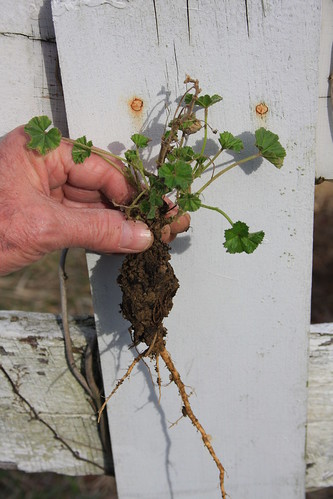
Transplanting winter plants to coldframe.
(*photo credit)
December 26, 2023 Proclaiming Jesus Christ Activist
I have come to bring fire to the Earth and how I wish it were blazing already! (Luke 12:49)
Among our works in progress for the past decade and not yet completed is the book "Jesus Christ Activist," for which I have already begun gathering data and which will continue to be a focal point in elderhood – if time allows. Why more written on Jesus? Perhaps, because some of this has not been said in the context of current activism and because others have interpretations of Jesus that do not fit the definition of activism in the modern sense. Certainly, those who are in dangerous situations of assisting virus victims or who are to confront an Isis warrior know of that activism. But what about the people in the comfort of a cushioned pew or a pulpit speaker seeking to unloosen purse strings?
The answer is that we are all called to be like Christ, and for many Christians an activist is conceived of in a disparaging manner. People think of acting before reflecting, being too forceful or irritating, being disrespectful of the status quo, or trying to make radical changes. Their suspicions are somewhat justified, but the true-blue activist opponent is frustrated: who really is this Jesus of Scriptures? For this "lamb of God" behaves in Scripture more aggressively when calling for a fire to e lit on the entire Earth.
What is starting to emerge in my research on this subject is that Jesus is activistic to the point of risking and actually cutting short his own ministry. His activism is of divine origin and is encouraged by the activism of his mother Mary as well. When asked to prove who he is, his proofs are deeds of an activist healer, comforter, and peacemaker. Jesus' activism is unrelenting and found in virtually every deed recorded. It becomes the model and template of what those who follow are to do. In fact, it is through a measured and balanced activism that we are to gain the kingdom of heaven -- and the judgment will be based on those deeds or the lack of them done for others. Lest we forget!
In many ways, a modern activism is countercultural, for the System in which we are immersed does not want forms of activism that calls for radical change and revolution. For the status quo seekers, who wants to confront the System and be ostracized? Injustice and inequality surround us on all sides. Who wants to tend the very ill or feed the hungry and demand that all of our militarism be bent in organizing social change for the good of all? Only someone who sees the activism of Jesus clearly sounded in Scriptures and then in prayerful recourse takes the call for service to be one of total activism to the degree that physical resources allow. This is why reflecting on what Jesus does is so necessary. Pray that this project can b3 completed.
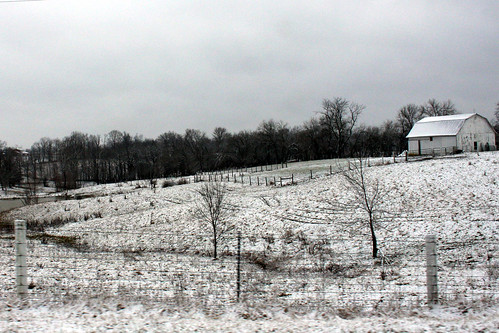
Rustic Kentucky farm scene in winter. Madison Co., KY.
(*photo credit)
December 27, 2023 Detecting Radon in Our Homes
The year is ending and it is a good opportunity to turn once more to our cozy homes. Most Americans are unaware that the second highest cause of lung cancer (after smoking) is naturally occurring radon gas, which could enter a home due to local rock formations and soil as well as home construction materials -- and remain due to poor out-gas ventilation. Over half of the country has a high or moderate chance that radon may prove a problem in a given residential area. Your state environmental protection agency can advise as to whether radon testing is needed.
If the house radon levels prove to be four picocuries per liter or higher, some form of remedial action is needed. Sometimes basements or below-ground resident areas prove unacceptably high, while above-ground living spaces fall within acceptable ranges. Retro-fitting the house will be somewhat more difficult than installation during construction. Radon reduction costs can range from one to three thousand dollars with an average cost in-between depending mainly on the size and design of the structure. Some techniques operate to stop the radon from entering the house in the first place (USEPA preferred methods), or to reduce the radon levels once in the house. Houses having basements or a slab-on-grade foundation may use one of four types of radon reduction soil suction methods: sub-slab suction (depressurization), drain tile suction, sump hole suction, or block wall suction. For houses with crawl spaces, an effective method is to cover the earthen floor with a high-density plastic sheet and draw the radon gas outdoors with a vent pipe and fan. Other radon reduction methods include sealing, house/room pressurization, heat recovery ventilation, and natural ventilation.
If it is determined that your house has a radon problem, you need to select a qualified radon mitigation contractor and to determine the appropriate radon reduction method. Installment requires a certain amount of technical skill and is not a do-it-yourself project. Read the contract before signing for installment of any reduction method. Try to understand how the particular system operates and what constitutes ensuring proper care.
A small amount of maintenance is also in order through the years. Less expensive systems may require more time and effort to maintain. The homeowner must look at the radon warning device on a regular basis to make sure the system is working correctly. Fans (never to be turned off) may last for five or more years and may need replacement. In radon problem areas, the USEPA advises retesting a house at least every two years. USEPA hotlines on radon: to purchase radon test kits 1-800-767-7236; to get live help 1-800-557-2366; and to get safe drinking water info 1-800-426-4791. Internet info at www.epa.gov/radon. Each state's EPA office can supply a listing of qualified state contractors.
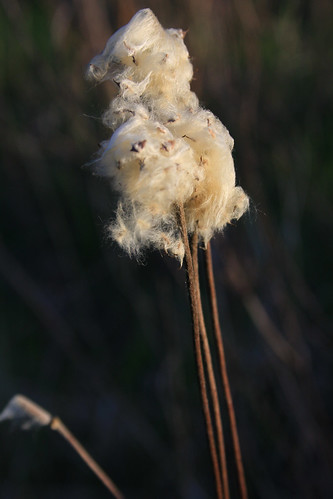
Seeds of thimbleweed, Anemone cylindrica.
(*photo credit)
December 28, 2023 Looking Back and Looking Ahead
A philosophical reflection is good as 2023 ends. When we are traveling, we can't both look back and ahead simultaneously, but we can in short intervals do one and the other. An authentic alertness means being present and doing all things well, not dwelling too long on either temporal direction, but still giving proper time to what has come and preparedness to what is ahead.
Review the past year. Year's end is an ideal time to look back over 2023 with all its headaches, a world of struggles, an economy that did not fully meet our expectations, and the numerous passing friends who departed this year. Usually it was a mixed bag as a warmer summer than expected, a better garden with some produce, or a mild malady that could have been worse. In retrospect, the year has its ups and down and we still have the breath to thank God for good things that happened.
Look to the horizon and future. We strive to be realists, if not optimists, and look ahead for more peaceful and prosperous times. Will next year be prosperous for us? Will a financial crash so often predicted come true or prove false once more? Will the end of the world come and can we do anything about it? More so, will climate change accelerate next year, and can we do our little part as citizen and homemaker? We have our wishful thoughts about more glorious days to come, but knowing all the while that it does not depend totally on what we do, but how well we strive to serve others.
The present moment is a gift. Being, more than doing, is what can define us at this moment and this makes the present the time we live fully NOW with all its demands on us. It is wise to make this end of year reflection in an atmosphere of thanksgiving, for we have survived the past and we await the future. This is a time to discover the love of God shown through merciful deeds. Thus, a review of major happenings of the past year is really a proper way to end one thing and begin another. This day is no different from others, except a new year is emerging.
A proper stance is worth praying for. Some speak of the need for new beginnings; let's be fair for if the present is the point where past and future meet then an equality of new starts and old endings need to have some neutral ground. Both past history and future horizon demand our attention, but each has its focal moments. A proper way of seeing things is to be an alert wayfarer looking not just to right and left but to past and future with constant attention to the road. Happy New Year!
Take, Lord, and receive all my liberty, my memory, my understanding, and my entire will, all that I have and possess. You have given all to me. To you, O Lord, I return it. Dispose of it wholly according to your will. Give me your love and your grace, for that is enough for me.
-- St. Ignatius Loyola

The sun sets on the year 2014.
(*photo credit)
December 29, 2023 Supporting the SUN DAY Campaign
In our awareness of climate change we need some way of knowing the fast developments in renewable energy development and replacement as well as advances in energy efficiency. Some mistakenly promote the phoenix of nuclear power as a viable alternative to replace non-renewable fossil fuel sources (coal, petroleum and natural gas). Others see renewables as apart from both fossil and nuclear options.
For years this website has depended on the work of those committed to renewable energy -- and the first to come to mind is Ken Bossong, executive director of the SUN DAY Campaign located at Takoma Park, Maryland. Over the years Ken has directed a variety of public interest energy projects for the Center for Science in the Public Interest, Public Citizen, the Peace Corps, and since 1993 has been concerned about SUN DAY. The Campaign is a non-profit research and educational organization founded to promote sustainable energy techniques as cost-effective alternatives to nuclear and fossil fuel sources.
Ken is highly creative and diligent; he has the ability to find key political issues and to muster public support for their implementation. Recently, Ken has contested the projected governmental estimates of renewable energy rates by 2030 and found them to be exceedingly low, calculating at current rates of renewable development. Ken's letters and efforts and those of supporters have resulted in realistic governmental revisions to prove that renewables are substantial and coming on board at a rapid rate -- though not fast enough. Ken is a lawyer and scientist, and he is a voice of conscience and author of safe energy resolutions, propositions, and impending legislation.
A principal service of the SUN DAY Campaign is a subscribed daily abstract service directed to pertinent articles on renewable and other energy issues, with specific instructions as to how to reach the original reports and studies. The service is at reasonable costs to both individuals and organizations. Two other projects associated with regular abstracting include collected series of these abstracts on energy efficiency and other subject lines as well as specific press releases as to important milestones in the growing renewable energy economy, especially percentages of electricity production from renewable energy sources. Subscribers have the opportunity to pass on renewable energy progress to local and regional media outlets. Readers are highly recommended to subscribe and follow the service.
The address is:
SUN DAY Campaign
6930 Carroll Ave., Suite #390
Takoma Park, MD 20912
Phone (301) 270-6477
<sun-day-campaign@hotmail.com>

Fast-appearing inkcap mushrooms in drizzle.
(*photo credit)
December 30, 2023 Being People of Service
As the year 2023 closes it is wise to reflect on how well we have been of service to the needs of others. At the same time, we may find it opportune to review our direct service commitments that depend so much on our energy and time levels as well as essential needs by those we serve. Each of us seeks the most opportune human situation to be of service. We focus a little more on the multi-faceted concept of "service" (with many definitions) and make a selection based on maximizing benefits to the needy. Key activist service characteristics include:
Openness: We have to be open to what the Lord wants us to do with our own individual talents and circumstances in life. Everyone can and must do service, but the ones we undertake and the manner in which we undertake them are uniquely ours, for they are based on our limitations, resources, and willingness to help.
Cooperation: We cannot work alone and so a corollary of the first characteristic is to join forces with others who can be a complement for our limitations and weaknesses.
Compassion: Over and over the believing Earthhealer recalls that our compassion equals that of Jesus who came to redeem all creation. Thus, we show compassion for suffering people and for all creation, for this is a "suffering with another."
Sacrifice: In a billion ways people have sacrificed for loved ones or others in need, and so each of us must construct our own method and approach of serving others. We first attend to local needs, but with our mind set on global problems we also extend our service to broader vistas where possible. Our prayers and sacrifices are for those creatures in distant places as well as local ones. Just as wrongdoing can affect the greater community, so can good actions. Because of her loving service St. Theresa of Lisieux (though bed-ridden) is patroness of foreign missions.
Joy and enthusiasm: In the past decade Pope Francis has made our joy in the service we do a major part of the effectiveness in that work. We are grateful to God for the privilege of being able to be of service and this brings on a peace of soul that is a source of profound joy.
Risks: Active service involves risks (travel or health dangers, misunderstandings, opposition from peers or others, failure to achieve assignments, etc.). Caregivers who have plunged into helping Ebola victims in West Africa are role models of how we are to be willing to give all when serving others.
Reevaluation: The server needs occasional time to see how things are going, and the end of the year is a perfect time.
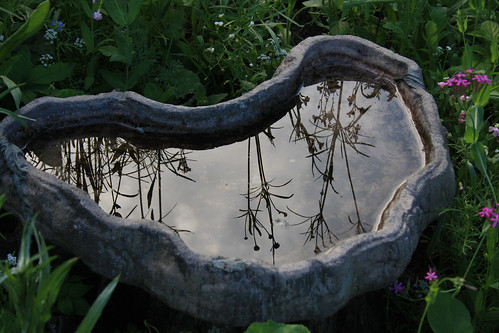
Summer memories from a small garden pool.
(*photo credit)
December 31, 2023 Celebrating the Holy Family and Our Families
For you shall eat the fruit of your handiwork;
happy shall you be, and favored.
Your wife shall be like a fruitful vine
in the recesses of your home;
Your children like olive plants
around your table. (Psalm 128:2-3)
Many people struggle with raising a family, and the cost of rearing; educating each child from birth to age 18 averages around two hundred thousand dollars (though differing widely by economic class). The difficulties in giving all these offspring the love and care they need makes us sympathetic with parental struggles. It does take a village to raise a child and more; it takes a community that is close to God and willing to help each other grow in faith, hope, and love. Family rearing is harder within a prevailing materialistic culture.
Today's Gospel tells of the presentation of the child Jesus in the Temple; his journey was beginning while two elders (Simeon and Anna) see their hopes fulfilled. Mary and Joseph give a pair of turtledoves (the offerings of the poor). In this formal temple setting at the beginning of Jesus' life the elders speak. Simeon is moved to make a formal proclamation: Jesus is to be a light to enlighten the pagans and to be the glory of the people of Israel. He and believers see the movement of the newborn and infant as a spark of light in the future, and a family is the best who share that light with each other; also, the horizon of the child is shared along with other youth in the family or neighborhood.
Simeon adds additional and very significant words about Mary, the child's mother: And a sword will pierce your own soul too -- so that the secret thoughts of many may be laid bare. It is quite evident in this pronouncement that child-bearing involves ongoing sacrifices and pain as Simeon foretells here. The family is meant to grow together and to share in suffering through real compassion. Parents are at the heart of family sacrifice and so in moving along with the advancing child to adulthood the family takes on a history of sacrifice, and the best of family -- like this Holy Family -- are willing not to allow the child to strike out on his or her own with no emotional and moral support, but to grow in being one with them in many ways. This becomes Mary's privilege and burden.
Parents are here for the long haul. Mary spends a lifetime reflecting in her heart on Simeon's words as Jesus grows, leaves home, launches his ministry, and is betrayed, suffers and dies for all. As special parent, Mary is spiritually one with her son. During the course of a lifetime that sword of sorrow is really a mixed blessing, for in doing God's will Mary has an abiding sense of joy to be part of this grand work of salvation.
An Opportunity for a New Beginning
By Fr. Al Fritsch, SJ
New Year's Eve is a time to reflect on the past year, embrace the present, and look forward to the year ahead. Some consider it an opportunity and a time to celebrate, but others dismiss it as not important at all. The question is – what are you celebrating? What’s getting ready to happen and what is your understanding of it? Folks all over the world have New Year's traditions they enjoy each year, but we’re asking you to consider this as a time for a new beginning.
Most of us are in need of a change in our life; wanting to improve is just part of who we are, but that doesn’t apply to everybody. Some people want their lives to stay exactly where they are, though this is rare. Most would like some degree of improvement, some change in their circumstances. And even though we should try to improve every day and be a little bit better for tomorrow, there are some bigger resolutions which may require the application of time, will – and grace. If we are serious about new beginnings, we will have to do some preparation. Looking at it in this way, none of us are perfect and all have room for improvement, and that’s what a new beginning is about. It’s about seeking forgiveness for imperfect actions done in the past and being completely open to being something better at this time.
More than hoping for what new things we WANT in the New Year, we assert our resolution to become something more than what we have been, especially involving some of the more important issues in our lives. We don’t bring all these up because they relate to our personal financial, political, economic, psychological and aspirational conditions, which differ from person to person. But a new beginning is something that we can all call for, something to make life better for everyone.
We are social beings. We can act individually and therefore talk about our own personal resolutions or the way in which we see the world by ourselves. But actually we are parts of a community with deep connections, families and various groups that we belong to. We have our undertakings and even duties which are done not separately but together, and this needs improvement also. So we can think in terms of what we can do together in 2024 to make the world a more peaceable, just, and equitable place in which to live. Here is our opportunity to recognize our interdependence, working together on resolutions which ultimately include the entire world.
Our future is always before us, though some do not look beyond the present moment to connect past actions to present outcomes, and to see that we create our future to some degree. God gives us the gift of time, but we ourselves must use that time well and make the future better. We can all agree that the terrible, seemingly never-ending wars of today must stop in order to save our wounded earth, to stop climate change effects. We must envision a good future ahead and believe that we can create it. We have to believe in our future and this is most important at this time when we speak about new beginnings. This is the time of year to start thinking very seriously about what we are about and what we are about to become.

